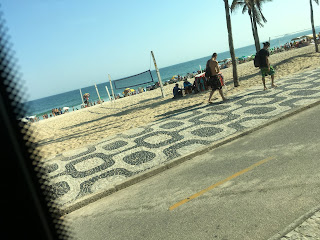Rio de Janeiro, Brazil
Sachi G. Dastidar
In September of 2019 Shefali and I took a trip through Brazil. Our
first stop was at Brazil’s Amazon Rain Forest, then to the newly-built capital
city of Brasilia, followed by a trip to Iguassu Falls of Argentina and Brazil,
and on the beautiful city of Rio de Janeiro. Iguassu is a junction of three
nations: Brazil, Argentina and Paraguay. Thus we journeyed to the Argentinian
side of the Falls, then made a brief trip to the Paraguayan border city of
Ciudad del Este.
If one lands at Manaus, the center of Amazon and the capital of
Amazonas State, as we did, one may not realize that one is landing in the
middle of a forest, as Manaus is a huge metropolis of 2.3 million people with
freeways, skyscrapers, theaters, hotels and restaurants.
These days we hear a lot about fires in Amazon. There was none
in the Metropolis. But we witnessed small fires set by residents during our
road trip to our jungle lodge, as well as when we flew over the forest going to
Brasilia. Most of the fires are at the edges of the forest as people were
land/forest grabbing at the edges going towards the center. Manaus is at the
center of the forest area, hundreds of miles from the border forest
fire/cleansing.
An added pleasure for this travel was that many Brazilians
looked like us, thus many locals took us for “locals” until we said something.
Then there were some who were confused learning that we Indians were not
traveling from India, but from the United States.
Rio de Janeiro or
simply Rio is known for her glamour, architecture, beaches, fancy neighborhoods
and favelas (illegally-occupied slums). True. She is famous for the statue of
Jesus the Redeemer, the World Cup football stadium, her Bohemian areas,
Sugarloaf Mountain with cable car ride, new Mexican pyramid-style new
cathedral, her famous Copacabana and Ipanema beaches, and lot more. The beautiful
stretch of beach is lined up with nice buildings, beach-side eateries, lanes
for biking and jogging, while the beaches are taken by barely-clothed women and
men where they try to get a suntan. Rio has a good public transportation system
with buses, cable cars (trams) and metro (subway). It is one of the largest
metro areas of the world, and is the second largest city of Brazil.
Brazil also has one of
the largest slums, favelas, of South America, often known for their violence.
These days there are tours to many favelas, including the largest and at-times violent
Rocinha. We took a tour of Rocinha, where a public bus ride and a short walk took
us to a height of about 800 meters. Tour group walked down the entire stretch
bringing us to the Metro station. In that process we walked over 2 kilometers
to the Metro station, at times walking down steps that are over 9” high, and some
time alleys were barely 14” wide. The tour showed us true success of
individuals among poverty, vio
Blue jean and
tee-shirt is the norm everywhere, except for offices when it is black trousers.
Many women wear extremely small pants, even those who are obese, and many men
prefer not to wear any shirt. Even in their late winter temperature always
hovered over 90 F, some places like Manaus with high humidity whereas dry in
other places like Brasilia.
In Rio and in every city we visited we tried local public transport, including Rio. In Rio we tried all
kinds of food as well, but possibly the best treat was a dish of a single fish. We have
never seen such a huge fish fried with batter, served with salad and French
fries. The fish was at least 18” long placed on a 2’-long oval tray, served
with fresh coconut drink or beer. We could barely finish a quarter of
the fish, with rest being exported to New York.
Rio in Pictures
At Christ the Redeemer Statue
Sugar-loaf Mountain with Cable Ride
Tour Friends of Bangladeshi-Brits and Bangla-Brazilians
Rio Beeches
The Bohemian Area
The New Cathedral built in Mexican-Aztec Pyramid Style
Rocinha Favela






































































































